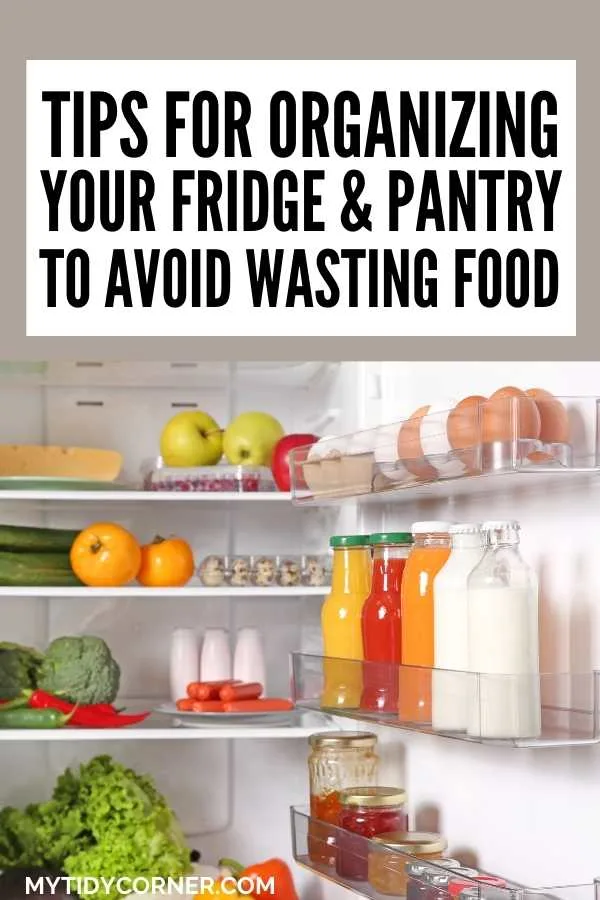8 Simple Tips for Organizing Your Fridge and Pantry to Avoid Wasting Food
Find out how to organize your fridge and pantry properly so you can avoid wasting food and save money.
Do you know the contents of your refrigerator? Over 35% of food produced inside the US goes to waste, and yet we complain of hunger. Chances are that a portion of the wasted food can be traced to our pantries and fridges.
Do you check your pantry or fridge before shopping to know what you need to restock? You might be surprised to learn how much food you can prevent from going to waste if you organized your fridge properly.
How you organize your pantry and fridge can also help keep the food inside fresh for a long time and save money.
Here are some tips to help you organize your fridge and pantry in a way that will help you avoid wasting food especially in these hard times.

Related Articles:
How to Organize Your Fridge and Pantry to Avoid Wasting Food – 8 Easy Organization Tips
#1. Keep Your Produce Visible
Keep all the food products in a visible place inside the pantry. The rule of out of sight, out of mind applies here. Do not keep fruits and perishable products in the back. If possible, process your fruits as soon as you get home and place them in containers in a visible place.
When you restock, keep the food in the right spots. Cans and long lasting food should go in the back. Mark expiry dates on these cans to track when the food inside might spoil.
#2. Group Things by Zones
Most of us have been arranging our fridge wrongly for the longest time. If you arrange the fridge correctly, you may save on electric costs and reduce food wastage. Here are tips on how to do it;
- Upper Shelves – Drinks, left-overs, herbs, ready-to-eat food
- Lower Shelves – Dairy, eggs, raw meat
- Crisper Section – Fruits and vegetables (kept separately)
- Freezer – frozen fruits, frozen vegetables, and stock food
- Door – Condiments, juices, water
Never refrigerate onions, tomatoes, squash, or potatoes. Do not freeze pre-stuffed meats, eggs in a shell, canned ham, and vacuum-packed salads.
#3. First In, First out
First in, first out (FIFO) model is not only found in accounting. It implies that the first thing that went into your fridge should be the first thing out. FIFO is a great strategy to avoid food wastage.
When we stock our fridge with new food supplies we never bother to bring the old foodstuffs to the front. And when accessing something in a hurry from the fridge, we tend to get what is closest to us.
The foodstuff at the back could go bad for staying too long in the fridge. New supplies have a new expiry date that is further from the one for old food supplies.
It makes sense to consume the old supplies first to prevent them from spoiling.
#4. Label Everything Inside Your Fridge
Label anything that is in an open container or jar. Sometimes it is easy to forget leftovers if they are not well-labeled. Once you place a container inside the fridge, label it to prevent guesswork on whether the food is okay the next time you want to use it.
Ensure you write the date you put the container inside the fridge to keep track of the freshness of the content inside the container.
Be creative with leftovers instead of throwing them away. For instance, you can repurpose them by heating them or adding new ingredients to make a different meal.
#5, Keep Your Condiments in Check
Condiments can take up a lot of space inside your refrigerator. If possible, buy a rack for them and place them on your kitchen countertop where you can access them easily.
If they have to be inside the fridge, keep them in the compartments on the door. They will be easily accessible from here and keep the refrigerator decluttered and organized.
You can also keep the condiments in check in pull-up drawers close to the kitchen countertop.
#6. Optimize Food Storage Using Containers
Storing foods in containers and jars makes the fridge look organized and saves space. Get different-sized jars or containers to help you optimize the storage space.
Place labels on these containers and remember to update the date whenever you remove something from them.
Replace opaque containers with transparent ones. You need to be able to see the contents of each container easily. Ensure that the packaging you buy is good for freezing.
Some of the best types of packaging for frozen food include:
- Glass Jars with Lids – Good for reheating food and for long-term use
- Ziplock Bags – Good for liquid stuff and stews
- Aluminum Pans – Good for quick packaging
- Plastic Containers with Lids – For short-term use
- Foil – For wrapping large chunks of food such as meat
Another great way of extending the shelf life of your food is by taking all the air out of the package using a vacuum cleaner before storing them away in your pantry or fridge. You will need these vacuum storage bags for that.
#7. Keep Lists
A list will let you know what you have inside the fridge and pantry to avoid wastage by buying more food unnecessarily. You can tape this list on the refrigerator’s door or wherever is more convenient for you.
When preparing food, you only need to look at this list to know what kind of meal to prepare according to the ingredients you have inside.
Update this list occasionally. Once you take something out of the fridge or pantry, note what you have left as this will help you decide whether to re-stock or not.
#8. Buy Less and Shop Often
Sometimes buying less can help you save more, especially if you have a small family. Buy less food and frequent the store when you need fresh supplies.
Stock your fridge with food supplies that do not expire quickly and buy perishables from the mall as often as possible. This will ensure that you not only will you have enough space to store the items, but you will eat fresh produce and avoid wastage at home.
Final Thoughts on How to Organize Your Refrigerator and Pantry
Keeping your fridge and pantry well organized will save you money in the long run. Avoid stocking too much perishable food, especially if you have a small family because there is a chance the food will go bad.
Make frequent trips to the mall whenever possible, and avoid impulse buying while you are there. The arrangement of your pantry can help you save a lot of food. Keep cans, long-lasting foods, and non-perishables in the back. Perishable foods should be kept in an easily accessible area.

